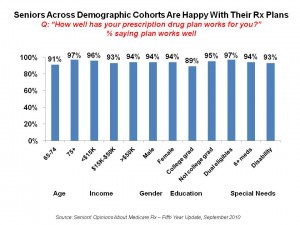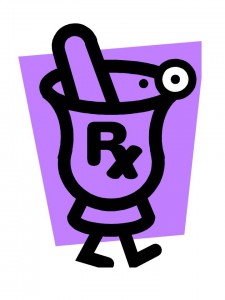 Contrary to stereotypes, older people can adapt, learn, and use new products and services. The introduction of Medicare Part D five years ago was an experiment in public policy, with some policymakers fretting about seniors’ ability to navigate a new system. It appears Medicare Part D is a hit, and people are working well with it across gender, age cohorts, incomes (from very low to upper-income strata), educational levels, and especially very sick and disabled people.
Contrary to stereotypes, older people can adapt, learn, and use new products and services. The introduction of Medicare Part D five years ago was an experiment in public policy, with some policymakers fretting about seniors’ ability to navigate a new system. It appears Medicare Part D is a hit, and people are working well with it across gender, age cohorts, incomes (from very low to upper-income strata), educational levels, and especially very sick and disabled people.
Among all seniors, 90% have prescription drug coverage. 61% of U.S. adults 65 and over have a Medicare prescription drug plan, 16% are covered by an employer-sponsored Rx plan, 3% have VA coverage, and 9% have some other source of drug coverage.
Overall, 84% of seniors are satisfied (“very” or “somewhat”) with Medicare Rx plans; over 50% are very satisfied. Most find the plans offer good value and would recommend Part D plans to their peers.
Satisfaction is highest among seniors with the lowest monthly premiums and out-of-pocket costs.
Even with 5 years’ worth of experience, however, there remains some confusion about the doughnut hole — the gap between what Part D covers and what seniors must pay out of pocket. While 7 in 10 seniors know about the doughnut hole coverage gap, only 2 in 10 know that, beginning in 2011, people who reach the doughnut hole will receive a 50% discount on brand-name drugs. Once hearing about this provision, 82% favor it.
KRC Research  conducted the survey on behalf of the Healthcare Leadership Council, a group of health care chief executives focused on quality, access and value in health care. 1,243 U.S. adults 65 and over were polled in August 2010 for this survey.
conducted the survey on behalf of the Healthcare Leadership Council, a group of health care chief executives focused on quality, access and value in health care. 1,243 U.S. adults 65 and over were polled in August 2010 for this survey.
Health Populi’s Hot Points: “Seniors are not hearing much about Medicare Rx in the news,” KRC Research observes. “Most of what they are hearing is negative.” Yet, seniors’ collective experience with five years’ worth of living with and using the Medicare Part D program, is positive.
Seniors are largely unaware of the future impact of the Accountable Care Act on the Medicare Rx program. In 2010, Part D enrollees with any spending in “the hole” will receive a $250 rebate. In 2011, enrollees with spending in the coverage gap will receive a 50% discount on brand-name drugs (provided by the pharma industry). Medicare coverage for generic drugs begins in 2011, and for brand-name drugs, in 2013. By 2010, Part D enrollees will be responsible for 25% of the cost of brands and generics in the doughnut hole, down from 100% in 2010.
Seniors have voted with their feet when it comes to picking Medicare Part D drug plans: they’re happiest with low out-of-pocket costs and easy-to-navigate plans. Let’s hope they vote in elections based on a solid understanding of what the plan has done for them in the past — and what it promises to do in the future.




 Interviewed live on BNN Bloomberg (Canada) on the market for GLP-1 drugs for weight loss and their impact on both the health care system and consumer goods and services -- notably, food, nutrition, retail health, gyms, and other sectors.
Interviewed live on BNN Bloomberg (Canada) on the market for GLP-1 drugs for weight loss and their impact on both the health care system and consumer goods and services -- notably, food, nutrition, retail health, gyms, and other sectors. Thank you, Feedspot, for
Thank you, Feedspot, for  As you may know, I have been splitting work- and living-time between the U.S. and the E.U., most recently living in and working from Brussels. In the month of September 2024, I'll be splitting time between London and other parts of the U.K., and Italy where I'll be working with clients on consumer health, self-care and home care focused on food-as-medicine, digital health, business and scenario planning for the future...
As you may know, I have been splitting work- and living-time between the U.S. and the E.U., most recently living in and working from Brussels. In the month of September 2024, I'll be splitting time between London and other parts of the U.K., and Italy where I'll be working with clients on consumer health, self-care and home care focused on food-as-medicine, digital health, business and scenario planning for the future...